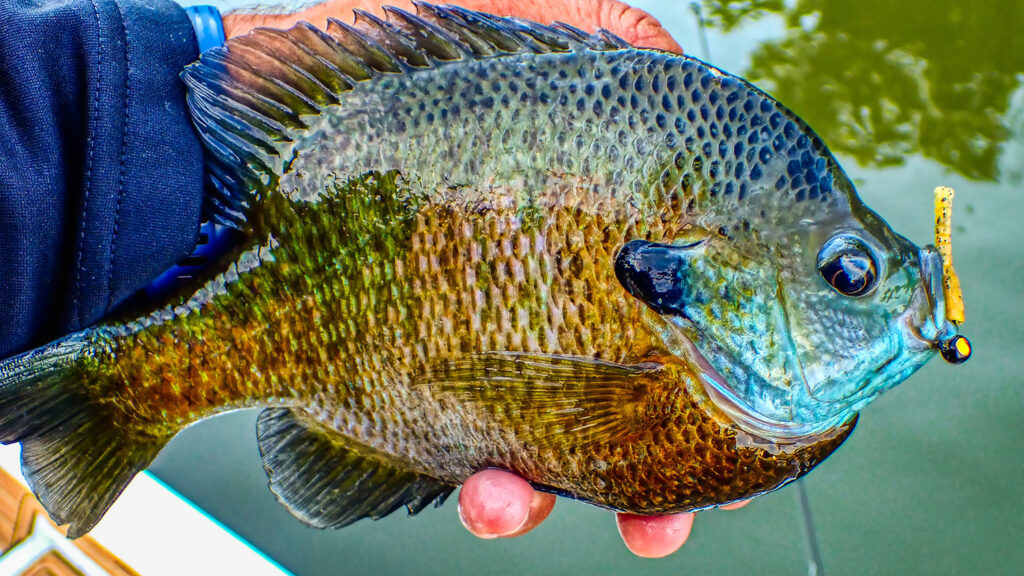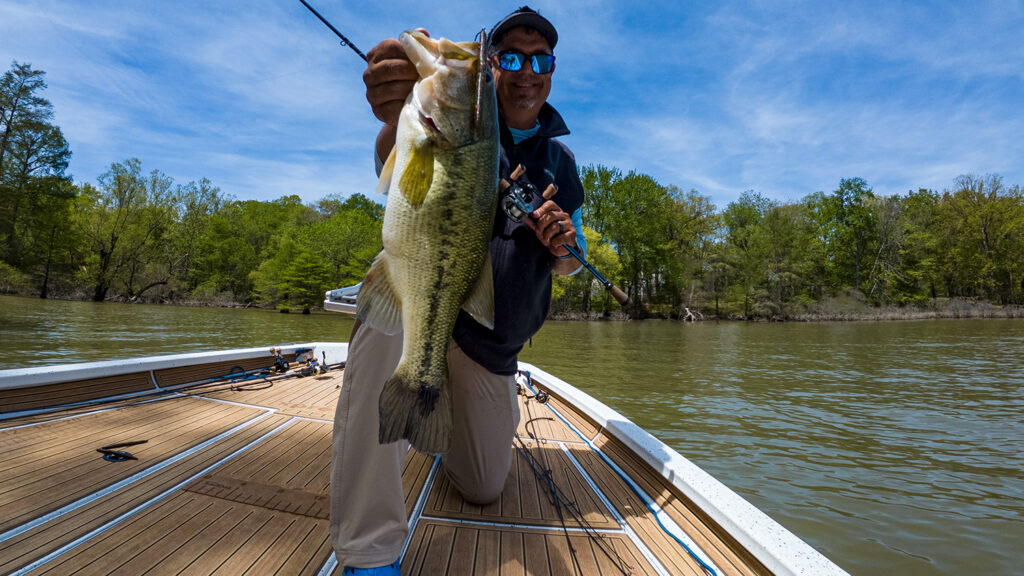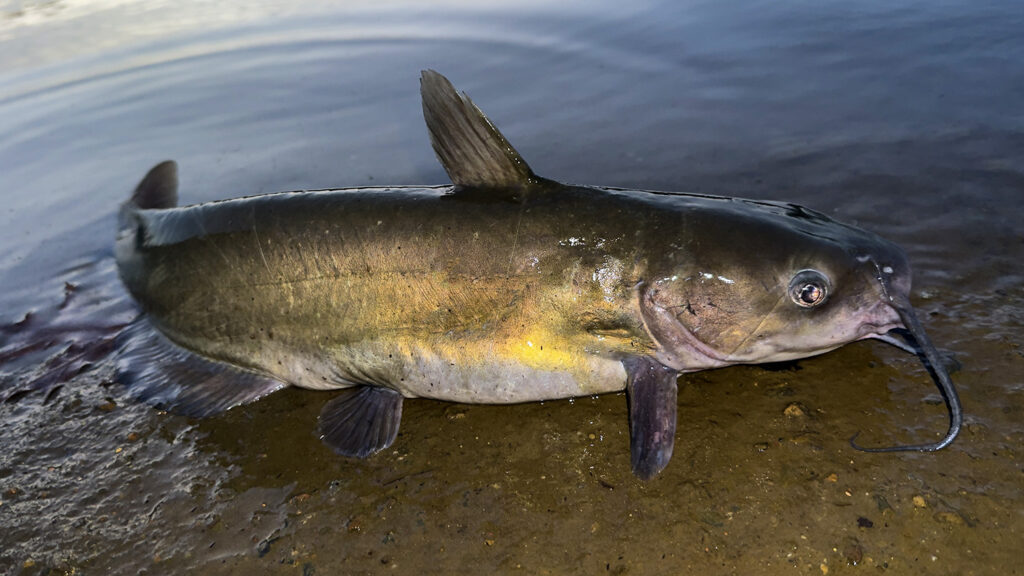Spring is when most people think of fishing. And a lot of it centers around vacations and activities with the kids. Fishing is a great way to spend time on the lake with the family and May is one of the best months on the lakes to share fishing with the whole family. That’s a time when the water has warmed up and the temps have warmed up and being on the water is more pleasant than not.
It’s also the time of year when a lot of fish come shallow to spawn and make themselves more accessible to anglers. Kentucky and Barkley Lakes are massive bodies of water and the fish spend a large majority of their lives out away from the bank. So when they do move in shallow I the spring and early summer, anglers can take advantage of some great fishing and consistent fast action.

Best Bite in May: Bluegills and Trophy Red Ear Sunfish
Hands down the best bite in May centers around panfish, specifically bluegills and red ear sunfish, aka shellcrackers. Panfish move shallow to spawn once the water temps reach around 70 degrees. Shellcrackers will begin bedding a little sooner than that but will still be bedding in late May and even early June.
And a lot of people don’t realize that bluegills specifically spawn in May, June, July and even August. But the biggest and best wave is usually that first one between the full moons in May and June. While you can see early bedding activity in April. The prime window is always May. Historically speaking, Memorial Day Weekend has been the peak of bluegill season for many moons.
To target bluegills and red ears in May, you will want to target shallow pockets from 1 to 6 feet of water. You can sometimes see the beds with your polarized sunglasses if they are shallow enough. A lot of time you are just looking for a big dark area in an other wise light bottomed area. The dark area is from them digging craters to form beds and cleaning all of the sediment and debris out of them to spawn and lay their eggs.
You can use modern electronics to find them. However, just taking a small 1/32-ounce Popeye hair jig or something like a Trout Magnet or Panfish Magnet body on small jighead cast on ultralight light 2 to 4 pound test and an ultralight rod and reel will allow you to probe areas until you find bluegill. Adding scent to your jigs helps a lot as panfish are very scent oriented.
Some anglers will tip their jigs with wax worms. While other successful panfish anglers opt for live bait in the form of crickets and red worms. Fished under a bobber or on a small drop shot rig, you can catch a lot panfish for supper on very simple setups.
Cast around sides and backs of pockets until you start getting bites and then hunker down in that area making repeated throws to the area to catch lots of bluegills in quick order.
Red ear sunfish, or shellcrackers as many call them, might be the most sought after fish on the lakes. We are fortunate that Kentucky and Barkley Lakes both offer trophy red ear fishing. Our shellcrackers often get to weigh more than 2 pounds and a 12 inch panfish is a true trophy anywhere in the country.
While we have a good population of red ear, you will catch 1,000 bluegill for every red ear you catch on the lakes. That’s how rare these fish truly are and the really big ones are rarer still. Yet May is maybe your best bet for catching a red ear on Kentucky or Barkley Lakes. The will feed on snails around their bedding areas and will be wanting to feed on the bottom. Set your bobber to just a few inches shallower than the depth your fishing. Or use something like a drop shot to keep your bait close to the bottom.
Work your lures or a live bait with short small pulls with lots of pauses to give the fish a chance to scarf up your offering.

Other Good Bites in May
Catfish move shallow become more active feeding before their big spawns in late May and June. Both Largemouth and smallmouth bass guard fry while also feeding on bedding bluegills and shad on the shad spawn. And crappie are post spawn moving to their summer brush and getting deeper as they move away from shallow spawning areas.
To target bass, you can find them with topwaters early and late and when the cloud cover offers a lot of extra low light fishing. Fishing around hard structures like rip rap walls, docks, and edges of cover can all be good for targeting guarding males as well as fish feeding on the shad spawn.
The shad spawn occurs at first light and some around last light. So you will only catch it for the first 30-45 minutes of day light unless you catch an overcast day. Small poppers, frogs, buzzbaits and more will all work to target these fish. As will things like Senkos, ChatterBaits, swim jigs and spinnerbaits. Even small crankbaits can be good on a shad spawn.
For catfish, looking for brush, stumps and rocky cover in mid depths will put you around a lot of feeding channel catfish moving to spawn. Manlike flats with stumps as well as brushy areas just inside the bays can be good as can be rip rap and rocky areas.

May is a Great Time to Be on the Water
There are lots of fish shallow usually in May and many fish are transitioning out to deep water as we get into summer. So good strategies often require fishing shallow early and late and moving out a little deeper during the day and as we get further into the month.
You can find good topwater fishing, great panfish fishing shallow and lots of opportunities for many different species of fish. If you’re unfamiliar with the waters, hiring a guide is a great way to get on a program fast.
